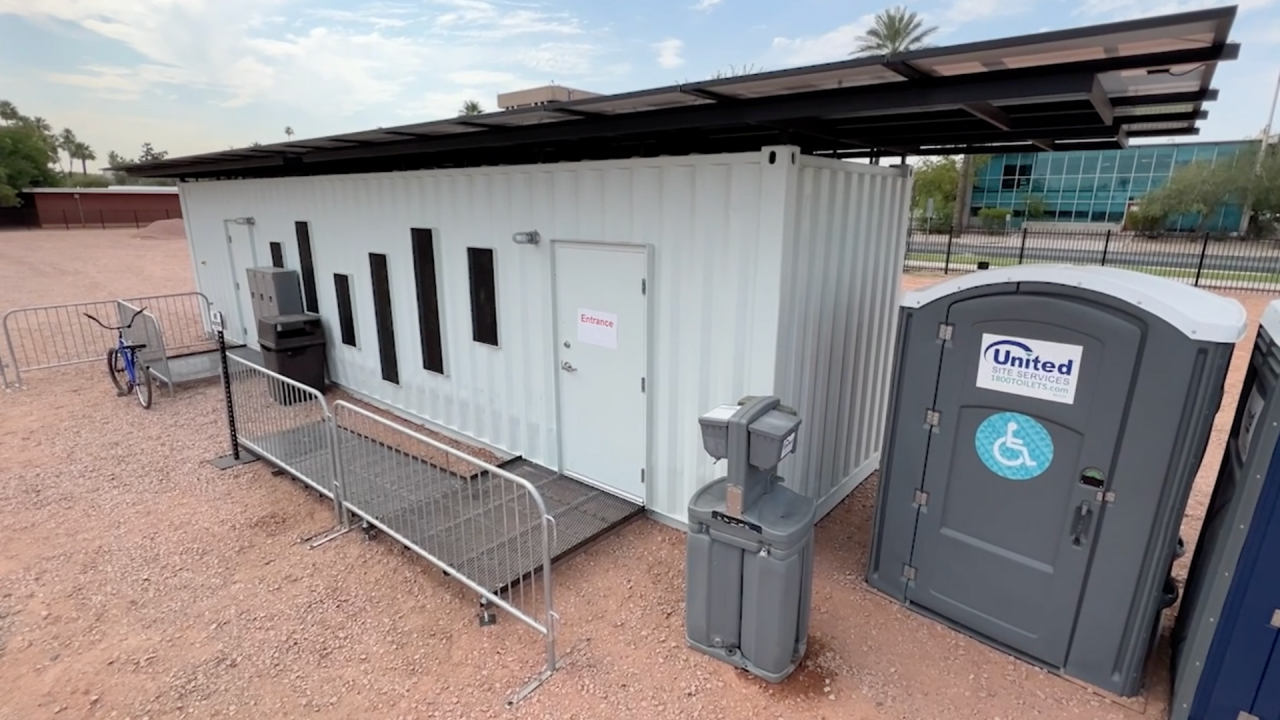Containers that once created a barrier between Arizona and Mexico have been retrofitted to provide relief from the sweltering heat.
A total of 18 solar-powered cooling containers are rolling out across the state, with two now open in Phoenix and more set to open in the coming weeks as part of Arizona’s Extreme Heat Preparedness Plan.
Chaz Glendenning said he was walking near the state capitol when he spotted a sign for the cooling container and dropped in to get a break from the scorching sun.
“Outside, [you'll] burn in a matter of minutes, and you come inside here and it's nice and cool,” Glendenning said.
Glendenning lives in a shelter. He said he ended up in the hospital for five days recently for dehydration, adding that the weather is already unbearable.
On June 6, Phoenix reached 113 degrees, breaking a record, and set another record the next morning with a low of 87 degrees. The previous record low of 85 degrees was set in 1977.
Gov. Katie Hobb’s office confirmed the repurposed containers are the same ones used by former Gov. Doug Ducey to create a barrier between Arizona and Mexico. The state spent nearly $2 million in federal funding from the American Rescue Plan to re-purpose 18 containers.
A spokesperson with the governor office said the state also sold 444 containers for $807,543, and currently has on hand another 1,600 shipping containers. It’s unclear how many of the containers sold came from the makeshift border wall.
Two mobile cooling units are set up in Phoenix, six will go to the Department of Corrections, and 10 units will go to local jurisdictions including Tohono O’odham Nation, Gila County, Tucson, and Pinal County.
“Just to see the ingenuity come to life is really great,” Arizona Faith Network Community Resilience Program manager Arene Rushdan said.
The Arizona Faith Network is overseeing the two units in Phoenix. Some have dubbed the repurposed cooling containers “cooltainers.”
The units are equipped with a refrigerator to keep water bottles cold, snacks, donated items, and Naloxone in case of an overdose. A security guard is also on-site for safety and a handful of lockers are available for use.
The cooling shelters have a capacity of 15 people. Rushdan said. If they fill up, they’ll have to set limits on how long people can stay inside.
The innovative cooling units were rolled out after a record-breaking summer in 2023 that baked the Grand Canyon State. On May 3, during a press conference, state officials announced that heat claimed 987 lives last year. Emergency rooms statewide recorded 4,000 heat-related visits, and cooling centers tracked more than 26,000 visits last year across the state, according to the Arizona Extreme Heat Preparedness Plan.
This month, Valleywise Health reported a dramatic jump in heat-related injuries. Between June, July, and August of 2023, 136 patients were admitted with severe burns, and 14 patients died from their injuries. In 2022, 85 people were admitted for heat-related burns and seven of the patients died from their injuries.

Weather
A heat dome is covering regions of the US, triggering excessive heat warnings
“When it's 110, 115,120 degrees in direct sunlight, the pavement can reach temperatures of 160, 170, even 180 degrees, which is getting pretty close to the boiling point of water,” Dr. Kevin Foster, the director of the Arizona Burn Center at Valleywise Health said.
He predicts the number of heat-related injures will be even worse this summer.
According to the National Weather Service, excessive heat is the leading weather-related killer in the United States, and scientists predict climate change will only continue to fuel hotter temperatures.
This week Accuweather is tracking the first widespread heat wave set to blanket the Midwest and the Northeast, and they predict 135 million people will face 90-degree temperatures or higher. The hot temperature is expected to tick up this weekend in the Midwest.
As the climate changes, Rushdan hopes Phoenix can help lead the way.
“I hope they can see Arizona as a pilot program, and as innovative, that they're doing this cooling right,” Rushdan said.
Glendenning sipped on a water bottle before he headed out into the heat.
“I’m very thankful for these and I’m sure they will save many lives,” Glendenning said.
This year alone, Maricopa County, the most populated county in Arizona, has tracked five heat related deaths, and 67 remain under investigation.




